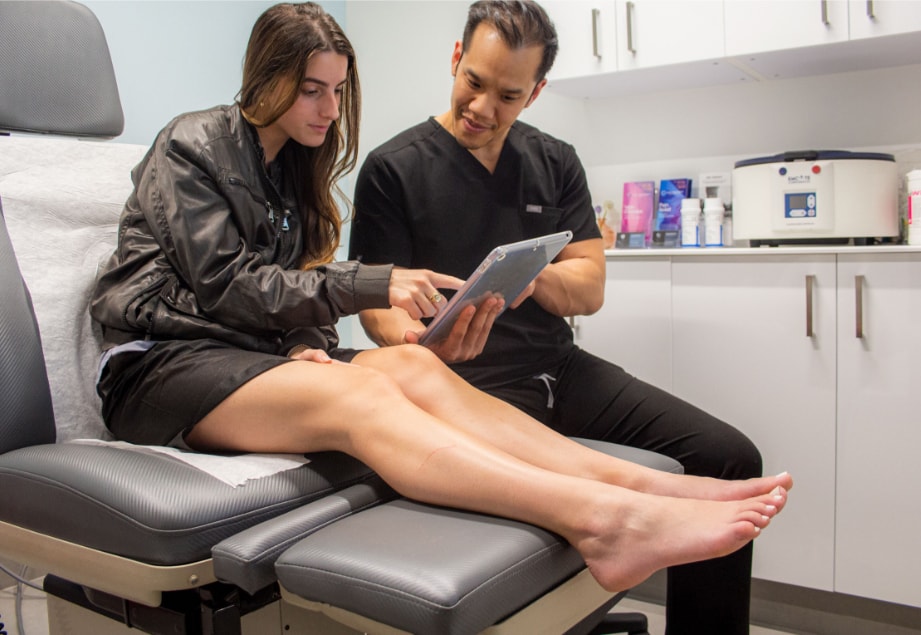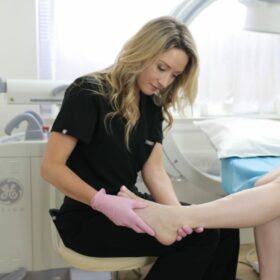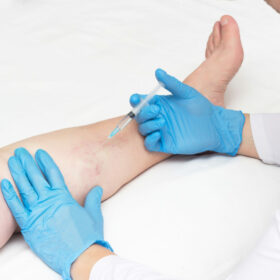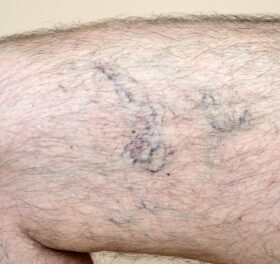What can you do to reduce varicose veins?
There are many things people can do to reduce the pain, discomfort, and unsightliness of varicose veins. Before we provide a list of home remedies and lifestyle changes to alleviate the symptoms, we must emphasize that these tips can only provide temporary relief. They can alleviate some of the symptoms of varicose veins and vein disease and prevent the condition from worsening. But they can’t treat varicose veins or the underlying vein disease. The only way to treat varicose veins is through minimally invasive procedures at a good vein center.
The following are some of the most effective ways to reduce varicose veins and spider veins:
- Avoid standing for long periods of time. If your job requires you to stand for long periods, take frequent breaks and walk around to improve circulation. If you stand or sit still for long periods, blood accumulates in the leg veins, leading to increased varicose veins.
- Exercise regularly. Exercise increases muscle tone and helps circulation, which can reduce the risk of varicose veins or improve existing ones. You should engage in cardiovascular exercises that increase blood circulation and engage your calf muscles, such as running, swimming, cycling, and yoga.
- Wear comfortable, supportive shoes. High heels can aggravate varicose veins, so it’s best to avoid them if you have spider veins and varicose veins. Instead, you should wear comfortable, supportive, flat shoes.
- Elevate your legs. When you’re sitting or lying down, elevate your legs above the level of your heart to help improve circulation. This will enlist gravity to push the accumulated blood toward the heart, taking some pressure off your leg veins. You should elevate your legs thrice a day for 30 minutes at a time.
- Avoid tight clothing. Wearing tight clothing, especially around the waist, can constrict blood flow and worsen varicose veins.
- Maintain a healthy weight. Carrying extra weight puts extra strain on your veins, so losing weight can reduce varicose veins or prevent them from worsening.
- Quit smoking. Smoking damages the valves in your veins that keep blood flowing in the right direction. When your vein valves are damaged, blood flows backward and accumulates in the leg, leading to vein disease and varicose veins.
These are just a few things you can do to reduce your risk of developing varicose veins or improve existing ones. But as mentioned previously, the only way to treat existing varicose veins is with minimally invasive varicose vein treatments, such as radiofrequency ablation, laser ablation, venaseal, and ambulatory phlebectomy. Our state-of-the-art vein treatment clinics offer cutting-edge, minimally invasive vein treatments to improve your vascular health without downtime or unwanted complications.
You can find our vein treatment clinics in New York City, Long Island, California, Washington, D.C., and New Jersey. If you’re in Long Island, you can find our vein clinics in West Islip, Jericho, or Hampton Bays — our south shore vein clinic is on the border of Nassau County and Suffolk County. Please schedule an appointment at your nearest vein clinic.
What happens if varicose veins are left untreated?
If you have varicose veins and wonder what will happen if you don’t treat them, you are not alone. Many people are reluctant to seek treatment because they think the condition is not serious. Unfortunately, if varicose veins are left untreated, they can lead to several serious health problems.
Varicose veins are caused by a weakening of the valves in the veins. When these valves are weakened, they allow blood to flow backward and pool in the veins. This can cause the veins to become enlarged and twisted. If left untreated, varicose veins can lead to several serious health problems, including:
- Blood clots: When blood pools in the veins, it can form clots. If a clot breaks loose and travels to the lungs, it can be fatal. This condition is called deep vein thrombosis.
- Skin ulcers: If blood flow to the skin is restricted, it can lead to ulcers. That’s because you need proper blood circulation to heal wounds. Without proper blood flow, your wounds won’t heal effectively, leading to non-healing ulcers.
- Bleeding: If the walls of the veins are damaged, they can bleed. Excessive varicose vein dilation can lead to profuse bleeding, for which you have to be taken to an emergency room.
Should I get my varicose veins treated?
If you have varicose veins, you may be wondering whether or not you should get them treated. The answer is YES! There are several reasons to undergo varicose vein treatments:
- Varicose veins can cause pain and discomfort. If you suffer from varicose veins, you may have pain and discomfort in your legs, especially when you stand for long periods. This pain can be greatly reduced by undergoing varicose vein treatments.
- Varicose veins can lead to more serious health problems. If left untreated, varicose veins can lead to deep vein thrombosis, leg ulceration, and other problems.
- Varicose veins can affect your self-esteem. If you are self-conscious about your appearance, you may find that your self-esteem is affected by your varicose veins. Undergoing varicose vein treatments can help you feel better about yourself and improve your self-esteem and mental health.
- Varicose veins can be treated successfully. There have been great advances in the treatment of varicose veins, and the success rate is very high. You can be confident that you will see results from your varicose vein treatments.
- Varicose vein treatments are minimally invasive. These days, varicose veins can be treated using minimally invasive procedures, such as ambulatory phlebectomy and vein ablation, that conclude within an hour and involve no major risks or downtime.












